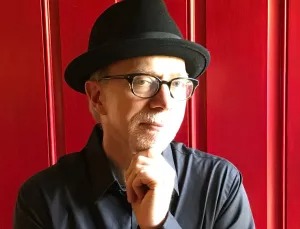Two years ago, while sitting in a hotel room in China, Steve Vai picked up a notepad and a pen and started doodling. “I don’t know why it happened, really,” he says. “Maybe I’d just meditated or something. All I know is, it was very liberating. I thought, ‘Nobody cares if I do this. I don’t need to be any more famous. I don’t have any expectations for this. This is my own little secret.‘”
Once he returned home, Vai set up a small art studio in an area outside his office and continued to create, using coloured markers, pastels – even nail polish. “It continued to be this expression of freedom,” he says, “but I think it’s because two things were happening: One, I wasn’t thinking. I was just doing. And two, I wasn’t criticising it. I made these my rules for doing art.
“But that’s the great thing about doing this – it’s available to everybody,” he elaborates. “All you’ve got to do is pick up a pen and let it go. There’s no way to explain it except that you become present with it, and you watch it, and it’s enjoyable. An impulse arises in the moment to move a particular way. That’s the best way I can put it. You look at it, and then another impulse arises. You don’t think. How could it not be enjoyable?”
Ten of Vai’s original paintings and signed prints were recently displayed at an exhibit put on his friend Ralph Rieckermann. Vai intends to continue with his art – time permitting. “I’ve got so many projects going on at one time, and there’s some really exciting music I’m working on for next year,” he says, adding with a laugh, “I’m definitely not putting down the guitar.”
Below, Vai offers his thoughts on five of his paintings. Limited edition signed prints are available through Vai’s official webstore.
Alligator Jungle
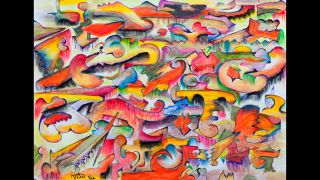
“It started with stick figures. The sketching and the outline probably took about two minutes, but the colouring in took days. I didn’t have much time – I have to do stuff on airplanes, in airports, tour buses, backstage, hotel rooms. But it didn’t seem to matter if I took a break and went back to it. I seemed to pick right up where I left off. ‘There’s the outline. Now what colours does it want?’ You develop the technique as you go.
“After I saw it and looked at it, it inspired me to want to study a little bit about dimensional painting, how to do things in dimension. You see, most great artists go through a tremendous amount of training. If you ever see Van Gogh’s work, he could draw things very realistically with depth. When he started doing his own real inner voice stuff, it was completely off the charts compared to what everybody else was doing. It was like [Stravinsky’s] The Rite of Spring.”
**Watcher Of The Skies **
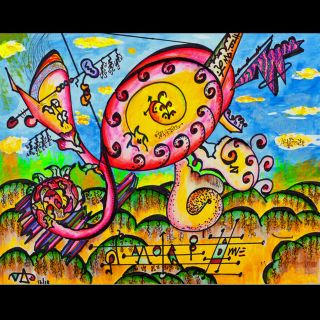
“I started to incorporate things like sparkle paint, nail polish, white Sharpies and other things. This was another one in which I had no idea what it was going to be. I just did the main image in about a minute. I looked at it and said, ‘This looks like it might be a creature of some kind.’ I started putting in the background, the hills, the sky – it just turned out to be what it is.
“It’s totally abstract. The thing that I think people feel when they look at abstract work is freedom. They feel the freedom that the artist had during the making of that piece of art. At least I hope that’s what people feel when they see something like this.”
**Emperor Penguin **
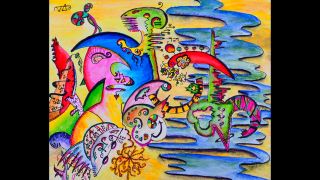
“Emperor Penguin was the last one I did. I decided to take a less-is-more approach to give more space to things, and it turned out really nice. It’s so surprising to me to look at it and see the dimension. What I’m really eager to start experimenting with is actual dimension, doing things where you can create a 3-D image.
“Artists know how to do this – I don’t. It has to do with capturing the light and depth of something. When I say the depth, I mean the actual physical depth of something. The depth of Emperor Penguin is there if you look into it, although it doesn’t have anything three-dimensional in it.”
**Perfect Pitch **

“Oh, my God, I loved doing this piece. I always thought that written music looked like art, so I said to myself, ‘How cool would it be to draw a page filled with musical symbols?’ And that’s what it is – everything in there is some kind of musical symbol, although distorted a bit. I just enjoyed it so much, and when you feel good that flows into the art. I can take this piece and look at every little square inch and feel the energy and joy of when I was doing it.
“And you know, it’s OK to enjoy your own work. You don’t have to self-deprecate yourself, and say, ‘I’m not a real artist.’ You just do it and it’s done. Do I think it’s great? I have no idea, and I don’t care. It’s relative to the viewer. To this viewer here, the fact that I did it is astonishing to me. It’s hard to kind of get this across without sounding pretentious, but it’s like, ‘I didn’t know I could do that!’”
When Worlds Collide
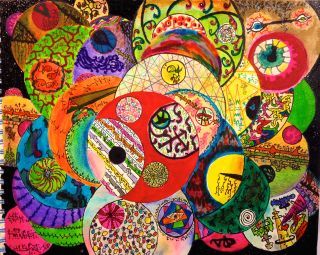
“I decide what tools I want to use the moment I start. With this piece, I was sitting on a tour bus; I had my paper, a pencil and a compass. I just started drawing all of these circles. You just kind of use a little bit of intuition, like ‘I want this one to go in back of that one. Let me try that. OK, this one looks like it can go there. I know, I’ll do this.’
“So I got all of these circles, and I thought, ‘What do I do now?’ The thought – this simple, stupid thought – was to fill in every one of them. Make them all different. Have some of them kind of like look like they belong, make some look like they don’t. It just happened. It actually took a lot of work.”

